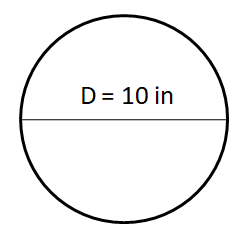
What is the area of a circle $10$ inches in diameter?
Answer
527.4k+ views
Hint: For finding the area of the circle of the given dimension we need to use the formula for the area of a circle which is given by $A=\pi {{r}^{2}}$, where r is equal to the area of the circle. In the above question, we have been given the value of the diameter of the circle to be equal to $10$ inches. The radius of a circle is equal to half of its diameter. Therefore, the radius of the circle will be equal to $5$inches. On finally substituting this value of the radius into the formula for the area of a circle, we will get the final answer.
Complete step by step answer:
We know that the area of a circle is given by the formula
$\Rightarrow A=\pi {{r}^{2}}.......\left( i \right)$
Therefore, firstly we need to find out the radius, r of the circle. We have been given the radius of the circle in the above question to be equal to $10$ inches.

Therefore, we can write
$\Rightarrow D=10\text{ inches}........\left( ii \right)$
We know that the radius of a circle is equal to the half of its diameter, that is
$\Rightarrow r=\dfrac{D}{2}$
On substituting the value of the diameter from the equation (ii) in the above equation, we get
$\begin{align}
& \Rightarrow r=\dfrac{10}{2} \\
& \Rightarrow r=5\text{ inches} \\
\end{align}$
Now, we substitute this in the equation (i) to get
\[\begin{align}
& \Rightarrow A=\pi {{\left( 5 \right)}^{2}} \\
& \Rightarrow A=25\pi \\
\end{align}\]
Finally, on substituting $\pi =3.14$ in the above equation we get
\[\begin{align}
& \Rightarrow A=25\times 3.14 \\
& \Rightarrow A=78.5\text{ i}{{\text{n}}^{2}} \\
\end{align}\]
Hence, the area of the given circle is equal to \[78.5\] square inches.
Note: Do not forget to write the unit for the area along with its value. Also, do not make the mistake of substituting the value of the diameter instead of the radius. To avoid this mistake, we can remember the second formula for the area of the circle in terms of its diameter as $A=\dfrac{\pi {{D}^{2}}}{4}$.
Complete step by step answer:
We know that the area of a circle is given by the formula
$\Rightarrow A=\pi {{r}^{2}}.......\left( i \right)$
Therefore, firstly we need to find out the radius, r of the circle. We have been given the radius of the circle in the above question to be equal to $10$ inches.

Therefore, we can write
$\Rightarrow D=10\text{ inches}........\left( ii \right)$
We know that the radius of a circle is equal to the half of its diameter, that is
$\Rightarrow r=\dfrac{D}{2}$
On substituting the value of the diameter from the equation (ii) in the above equation, we get
$\begin{align}
& \Rightarrow r=\dfrac{10}{2} \\
& \Rightarrow r=5\text{ inches} \\
\end{align}$
Now, we substitute this in the equation (i) to get
\[\begin{align}
& \Rightarrow A=\pi {{\left( 5 \right)}^{2}} \\
& \Rightarrow A=25\pi \\
\end{align}\]
Finally, on substituting $\pi =3.14$ in the above equation we get
\[\begin{align}
& \Rightarrow A=25\times 3.14 \\
& \Rightarrow A=78.5\text{ i}{{\text{n}}^{2}} \\
\end{align}\]
Hence, the area of the given circle is equal to \[78.5\] square inches.
Note: Do not forget to write the unit for the area along with its value. Also, do not make the mistake of substituting the value of the diameter instead of the radius. To avoid this mistake, we can remember the second formula for the area of the circle in terms of its diameter as $A=\dfrac{\pi {{D}^{2}}}{4}$.
Recently Updated Pages
The number of solutions in x in 02pi for which sqrt class 12 maths CBSE

Write any two methods of preparation of phenol Give class 12 chemistry CBSE

Differentiate between action potential and resting class 12 biology CBSE

Two plane mirrors arranged at right angles to each class 12 physics CBSE

Which of the following molecules is are chiral A I class 12 chemistry CBSE

Name different types of neurons and give one function class 12 biology CBSE

Trending doubts
Fill the blanks with the suitable prepositions 1 The class 9 english CBSE

Who among the following opened first school for girls class 9 social science CBSE

What does the word meridian mean A New day B Midday class 9 social science CBSE

What is the full form of pH?

Write the 6 fundamental rights of India and explain in detail

Which places in India experience sunrise first and class 9 social science CBSE





